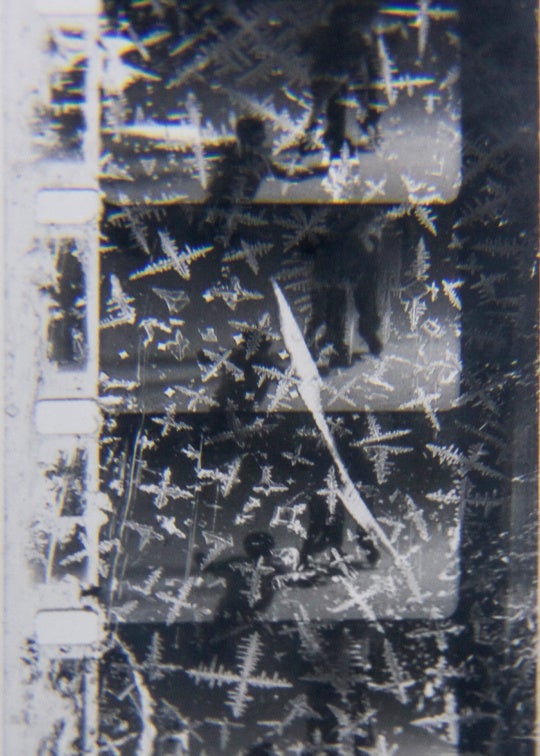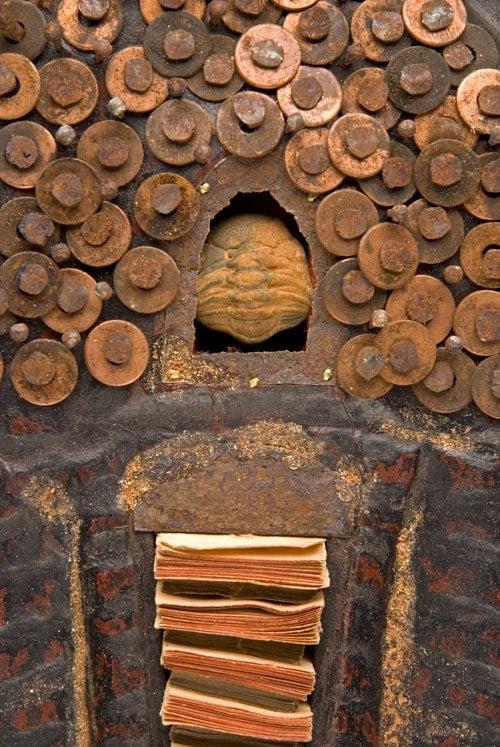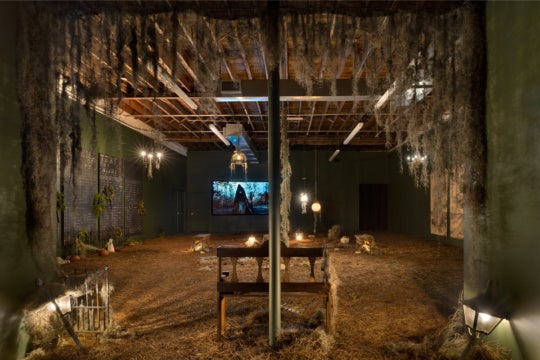
It’s not a first association, but New Orleans is a place steeped in nature. One can’t help but feel that the swamps, the alligators, the Gulf waters and the rainy seasons can reclaim the city at any moment. And yet it endures as one of America’s oldest and most cherished cities. Entropy, mold, vegetation, the ebb and flow of tourism and festivals, and a laissez-faire attitude towards alcohol—all eat away at any ideal of neatly maintained neighborhoods and society.
The tenants of spectacle and escapism, for which the city sells itself, too often overshadow the otherwise prolific and dominant Nature that is so very present in this place. What I especially love about artist Lee Diegaard is that she is in constant contact with this aspect of New Orleans and that is reflected in her work. Her sympathy and intelligent curiosity overflows to the more subtle worlds of plants, Earth and animals.
Diegaard meets me at a very plain café in the Garden District late this Spring. Wiry and wearing the glasses of an intellectual, she is calm and no-frills, but pulled off her face is a mass of long and curly (potentially wild) hair. It is clear from her vocabulary that she is a reader—and only once did she mention that she went to Yale—yet there is also an easy-going-ness which obviously allows her to be a part of the community’s scruffy, creative scene. Other than tromping through the woods at night, Diegaard has no formal studio. She does, however, have the keys to a gallery around the corner. We walk a few blocks to where she opens up a rather nice storefront gallery. Student photography—made from real film, she notes—hangs salon style, san frames. We sit and chat about what happens when artists who have only known digital photography use film for the first time. The conversation then meanders toward the animal kingdom—wild cats in the woods of North Georgia and the tragic saga of Topsy the elephant.


Karen Tauches: Where are the photographs from your Unbidden series shot? Is this an ongoing exercise?
Lee Diegaard: I see the series Unbidden as a long-term investigation. It is certainly ongoing, though subsets of it hold their own as groupings. I shoot most of them in rural Northwest Georgia where the animals are wary and watchful.
KT: You employ “night shooting” (forgive the expression!). I find it very profound how you co-opt the language and posture of hunting. Looking through your website, I see that nocturnal animal imagery appears in past exhibits as well as in your recent show at The Front.
LD: Yes, while technically safe on the land where I work, the animals live in an area with endemic hunting. I wanted to co-opt some of the tools hunters use but for the purposes of making portraits of animal individuals. Several of the deer have been subjects more than once, spread over years.

KT: Even when talking about horses, you mention the “pasture at night” and “night mares.” This must be a somewhat symbolic idea for you. Nighttime is indeed the Dionysian realm—where animals and imaginations run free, where minds roam unconsciously, where the safety nets of society are up…a place where, if you show up, you better know the animals and land on their own terms.

LD: What you said about the intrigue of night is utterly true. When I was a teenager, I went scuba diving at night. And all I could see at any point was by narrow flashlight beam. No three dimensional perception. The vast weight of the dark sea surrounded me. My sight reduced to the linear and pinpoint.
Flashlight beams shone into the woods or a hillside reveal the eyes of hidden creatures outside human awareness. I thought a lot about animals roaming freely at night, still vulnerable to predators, but uncircumscribed by human activity.
The tapeta lucida reflects white from the backs of their eyes, and the mild infrared flash suggested to me that the animal is looking past me, looking through the viewer. This addresses a sense of trespass I feel when entering their space.
In using the camera with horses, I’m addressing some of the acutely sensitive awarenesses—proprioreceptive, sometimes nearly extra sensory—in their interactions with humans. Growing up I dreamed of horses. It’s difficult to make art about horses. They are preternaturally beautiful, and their beauty can be all-inclusive. I am interested in a sense of intimacy. Like when an octopus swam into my flashlight beam, how a horse can loom close, breaching, in a way, like a whale at the surface of being barely seen. The titles Hypnogogue and Hypnopomp address this.

KT: How long have you lived and worked in Louisiana? Why did you choose to stay in this place as an art-maker? (You are originally from Atlanta, correct?)
LD: I’ve lived in New Orleans since 2002. Family reasons encouraged me to stay initially, but since Hurricane Katrina and the rise of the St. Claude Art District—the only all artist run arts district—has been immensely exciting, offering both autonomy and opportunity for a lot of artists, myself included.
Old old trees, old houses, migratory water birds count among New Orleans’ attractions—
KT: Although you teach photography at Tulane University and recently won the Clarence John Laughlin Award (given by the New Orleans Photo Alliance), you claim to be “unmarinated” in photography. I love this term, and I take it to mean that you are not bound to photography for your artistic identity or as a formal process. You are not mesmerized, as many photographers are, by the equipment and the technical prowess it often requires to get good results. Although you quietly master the technical aspects of the medium, I see your work as being much more content driven. Your deep empathy for the non-human constituents (animals, water, land, forests, etc) carries through most of the work that I’ve seen. The photography part becomes just a vehicle. Do you have any further comments about this?
LD: My MFA is in sculpture and I also studied a fair amount of drawing and painting. “Unmarinated” in photography remains an apt, if ungrammatical, term. I have practiced photography my whole life but hardly ever called myself a photographer. Perhaps because of “credential-ing” but more because I absolutely can be mesmerized by craft—I have remained essentially untutored. In a way, I take that to mean having freedom to follow the ideas first. It’s important to feel able to perform “hackery” in order to make a start and to use the tools you do have to their best purpose as you define it. Differing techniques and levels of craft should in the end bond legibly with what you’ve made. Whether you get to your destination via process and exquisite tools or by improvisation and accident, that does not matter. The gift of photography is how utterly democratic it has become in terms of equipment. How fluidly and fast it is possible to work. Even, especially for me, the gift of volume. Sometimes you can only identify the special result through a lot of sorting.
KT: You mentioned that you lost your studio and equipment, which opened you up to the more practical & ephemeral medium of video. Was this loss a result of Katrina?
LD: I did lose a much-loved studio to Hurricane Katrina. It was in the Upper Ninth Ward and carries the dubious distinction, based on the city’s animated flood map, of being the first small section of town to be inundated, even ahead of the levee breaches. I’ve never quite replaced the space. Which while dark and hot as hell, when it wasn’t cold, it was a productive place for me.
Since the loss of that studio, I’ve definitely relied more on work I can develop within a digital virtual space. Some degree of reproducibility, of archiving as a copy definitely appealed to me, as did portability in the face of the coming storm.
It’s a balancing act—acquiring materials and equipment often abuts with affording space. Lately I’ve been doing a lot of work in my driveway with chainsaws and circular saws. The torrential rains we’ve been having do complicate this kind of workflow. As you’ve noted, I do prioritize getting into the woods to work.
KT: I wanted to mention the bit about Topsy, the elephant who was so famously electrocuted by Edison in 1903. Her story is so tragic, just as tragic and complex as any human being. In addition to an exhibit for Topsy—for the Coney Island Museum in Brooklyn, NY—your online memorial still floats out there. Her spirit lives on as yet another Internet ghost. I’m wondering what motivated you to memorialize her? What are you hoping to achieve?

LD: I did that project as an act of witness. I don’t like to be didactic, but hope to elicit empathy for a grand and unfortunate animal protagonist. We made good use of her as a criminal and a monster, but of course it’s more complex than that. What voice did she have? Who stood up to the injustices she endured?
KT: I read a story once about an elephant that was a citizen of a small town in India, in the late 19th century. It’s hard to imagine now, but he was able to live a totally independent life, bartering for his shelter and food, doing odd jobs, moving and hauling large things on a freelance basis. (Now you’d rent a tractor or U-Haul truck.) It blows my mind, the idea of an animal citizen! But this is the exception and also a relic of the rural past: We are not saving room for the independence of animals in our everyday lives and culture. Instead, we know the large animals—lions, tigers, bears, whales, etc—only through their virtual identities in myths and children’s stories. Sorry to digress . . .
What is your next art adventure after Immersive Space: FLOW at the Alexandria Museum of Art, Mar 1- May 11, 2013?
LD: Even as I type, I am at work installing Pulse, an installation utilizing large scale and all scale projections. It’s at the Acadiana Center for the Arts, a lovely art center space in the heart if Cajun country.
More from the Unbidden series will be part of my solo show at the Ogden Museum of Southern Art in New Orleans in January 2014.
Other projects are ongoing, too. . .
Raised in Atlanta, Lee Deigaard has lived in New Orleans since 2002. She graduated with honors from Yale University with a major in fine arts and earned graduate degrees from the University of Michigan School of Art and Design and from the University of Texas at Austin where she held a Michener Fellowship in Creative Writing. She recently won the Clarence John Laughlin Award for photography administered by the New Orleans Photo Alliance, First Prize at the Southern Open at the Acadiana Center for the Arts for her video installation, and is represented in the Drawing Center’s Viewing Program in New York. Her Memorial to Topsy the elephant is on permanent display at the Coney Island Museum in Brooklyn, NY. She has been a member of The Front since 2010.
Karen Tauches is an artist, designer and independent curator in Atlanta.
House rules for commenting:
1. Please use a full first name. We do not support hiding behind anonymity.
2. All comments on BURNAWAY are moderated. Please be patient—we’ll do our best to keep up, but sometimes it may take us a bit to get to all of them.
3. BURNAWAY reserves the right to refuse or reject comments.
4. We support critically engaged arguments (both positive and negative), but please don’t be a jerk, ok? Comments should never be personally offensive in nature.




